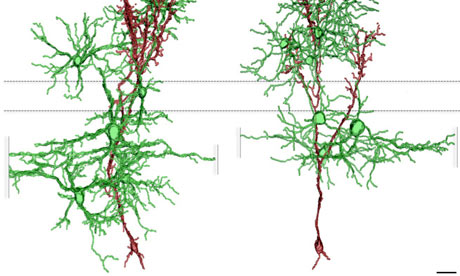Welcome to DU!
The truly grassroots left-of-center political community where regular people, not algorithms, drive the discussions and set the standards.
Join the community:
Create a free account
Support DU (and get rid of ads!):
Become a Star Member
Latest Breaking News
General Discussion
The DU Lounge
All Forums
Issue Forums
Culture Forums
Alliance Forums
Region Forums
Support Forums
Help & Search
Science
Related: About this forumFluorescent rabies virus tracks how experience alters neural circuits
http://www.guardian.co.uk/science/neurophilosophy/2012/jan/04/neuroscience-human-biology
Computer reconstructions showing microcircuits with synaptic contacts onto newborn granule cells (scale bar = 15 micrometres). Image: Arenkiel et al (2011)
Contrary to an age-old dogma, the brain is not fixed and immutable. After decades of research, we now know that the brains of mammals – including humans – can produce new cells after embryonic development is ended. We also know that experience alters the connections between nerve cells in a number of ways, and it is widely believed that this process, which is referred to as synaptic plasticity, is critical for learning and memory.
The adult mammalian brain contains two discrete niches of stem cells which retain the ability to generate new neurons. In rodents, it is well established that newborn cells integrate into the existing circuitry and contribute to information processing, but exactly how is unknown. Researchers from the Baylor College of Medicine and Duke University now reveal some of the details of these processes. Using genetically engineered rabies viruses, they show how new cells form connections with older ones and how their connections are modified by sensory experience.
Benjamin Arenkiel and his colleagues used a technique called monosynaptic tracing, developed by Ed Callaway of the Salk Institute, which exploits the natural properties of the rabies virus. Rabies specifically targets cells in the peripheral nerves. Following infection at the nerve endings in the skin, the viral particles are carried along the nerve fibres into the brain, by means of the neuronal machinery that transports cellular materials back and forth.
In a technically challenging and time-consuming series of experiments, the researchers created genetically engineered mice in which small numbers of neurons born post-natally (or after birth), and all the older surrounding cells to which they have become connected, are labelled with fluoroescent protein markers.
InfoView thread info, including edit history
TrashPut this thread in your Trash Can (My DU » Trash Can)
BookmarkAdd this thread to your Bookmarks (My DU » Bookmarks)
2 replies, 1061 views
ShareGet links to this post and/or share on social media
AlertAlert this post for a rule violation
PowersThere are no powers you can use on this post
EditCannot edit other people's posts
ReplyReply to this post
EditCannot edit other people's posts
Rec (3)
ReplyReply to this post
2 replies
 = new reply since forum marked as read
Highlight:
NoneDon't highlight anything
5 newestHighlight 5 most recent replies
= new reply since forum marked as read
Highlight:
NoneDon't highlight anything
5 newestHighlight 5 most recent replies
Fluorescent rabies virus tracks how experience alters neural circuits (Original Post)
xchrom
Jan 2012
OP
jberryhill
(62,444 posts)1. I liked the old incandescent ones better!